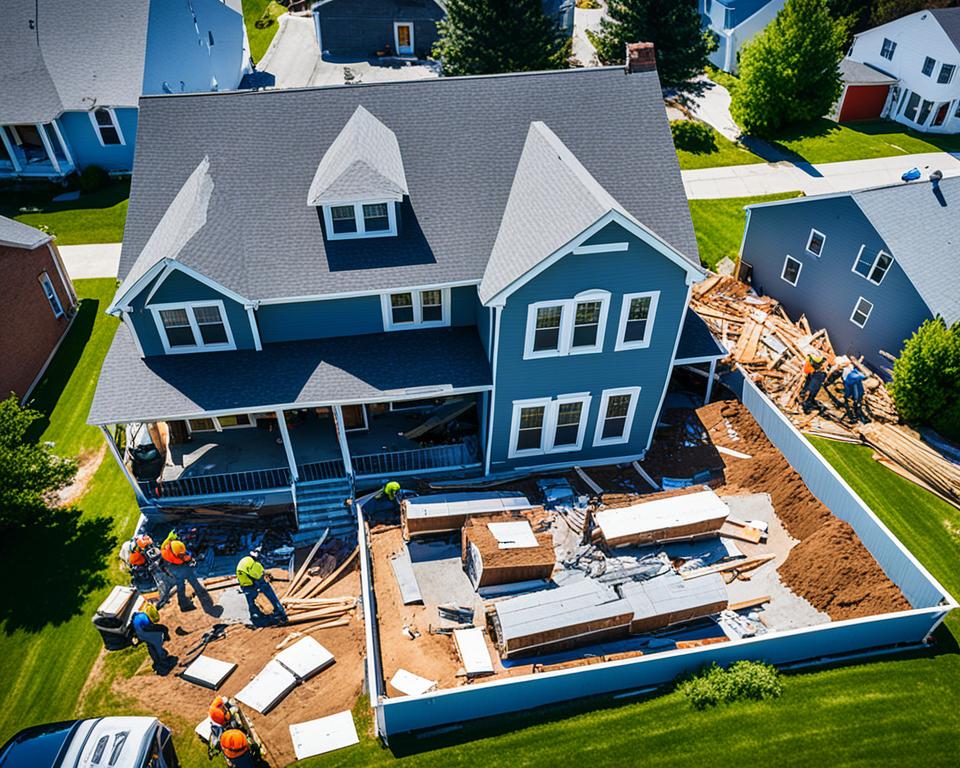Unlock the secrets to building wealth through real estate flipping, a strategic approach to property investment that has the potential to generate substantial profits. This comprehensive guide explores the art of real estate flipping, providing a step-by-step roadmap to help you maximize your returns and achieve financial success.
At the heart of real estate flipping lies the ability to identify undervalued properties, renovate them, and then quickly resell them for a profit. By understanding the key steps in the flipping process, you’ll learn how to navigate the real estate investing landscape, secure financing, and manage risks effectively, all while building a thriving house flipping business.
Whether you’re a seasoned real estate investor or just starting your journey, this guide will equip you with the knowledge and tools necessary to capitalize on the lucrative fix and flip opportunities in the market. Dive into the world of short-term real estate and discover how to unlock the full potential of property renovation and residential rehab projects to maximize your real estate profits and achieve your financial goals.
Understanding the Real Estate Flipping Process
Real estate flipping, a captivating investment strategy, involves purchasing undervalued properties, renovating them, and then reselling them for a profit. This process presents a unique opportunity for savvy investors to capitalize on the dynamic real estate market and generate substantial returns. Let’s dive into the key elements that define the real estate flipping process.
What is Real Estate Flipping?
Real estate flipping, also known as fix and flip properties, is the practice of acquiring properties, typically at a discounted price, renovating them, and then reselling them for a higher market value. This strategy allows investors to leverage their expertise in property renovation and market timing to generate significant profits from short-term real estate transactions.
Key Steps in the Flipping Process
Successful house flipping strategies involve a well-structured approach that encompasses several critical steps:
- Market Research: Conducting a thorough analysis of the local real estate investment market to identify undervalued properties with high potential for appreciation.
- Property Acquisition: Sourcing and securing the right property renovation opportunities, often through cash purchases or specialized financing options.
- Renovation Planning: Developing a comprehensive renovation plan that maximizes the property’s buy and sell homes value while staying within a realistic budget and timeline.
- Project Execution: Overseeing the renovation process, ensuring quality workmanship, and managing costs effectively.
- Marketing and Sale: Effectively marketing the renovated property to attract prospective buyers and negotiating a favorable sale price to capitalize on the real estate flipping process.
By understanding and executing these key steps, investors can navigate the real estate flipping process with confidence and maximize their returns on fix and flip properties.

Identifying Profitable Investment Opportunities
Successful real estate flipping hinges on identifying the most promising investment opportunities. This entails a multi-faceted approach that encompasses thorough market analysis, property evaluation, and accurate cost estimation. By mastering these crucial steps, investors can maximize their chances of achieving substantial returns on their real estate flipping ventures.
Analyzing Real Estate Markets
The first step in identifying lucrative real estate flipping opportunities is to conduct a comprehensive analysis of the local property market. This involves closely monitoring market trends, such as average home prices, sales volumes, and days on the market. By understanding the nuances of the market, investors can pinpoint undervalued properties with strong potential for appreciation. Closely tracking market conditions and identifying emerging neighborhoods with growth potential can help investors stay ahead of the curve and uncover hidden gems.
Evaluating Properties for Flipping Potential
Once investors have a solid understanding of the local real estate market, the next step is to evaluate individual properties for their flipping potential. Key factors to consider include location, condition, and renovation requirements. Properties in desirable neighborhoods with good amenities and accessibility are often prime candidates for flipping, as they are more likely to attract a wider pool of potential buyers. Additionally, assessing the property’s condition and estimating the cost of necessary renovations is crucial in determining the overall profitability of the project.
Estimating Renovation Costs
Accurately estimating renovation costs is a critical component of the real estate flipping process. Investors must carefully analyze the property’s current condition and develop a detailed plan for the necessary improvements. This may involve consulting with contractors, obtaining detailed cost estimates, and accounting for any unexpected expenses that may arise during the renovation process. By having a realistic understanding of the renovation costs, investors can make informed decisions about which properties to pursue and how to structure their investment strategies for maximum profitability.
| Real Estate Investment Opportunities | Property Market Analysis | Evaluating Flip Properties | Estimating Renovation Costs | Property Investment Strategy |
|---|---|---|---|---|
| Identifying undervalued properties with strong potential for appreciation | Closely monitoring market trends, such as average home prices, sales volumes, and days on the market | Assessing the property’s condition, location, and renovation requirements | Developing a detailed plan for necessary improvements and obtaining accurate cost estimates | Aligning investment strategies with market conditions and property-specific factors to maximize returns |
| Focusing on desirable neighborhoods with good amenities and accessibility | Tracking emerging neighborhoods with growth potential | Prioritizing properties that require manageable renovations and have a wider pool of potential buyers | Accounting for unexpected expenses that may arise during the renovation process | Leveraging data-driven insights to make informed investment decisions |

Financing Your Real Estate Flipping Project
Securing the right financing is a crucial aspect of successful real estate flipping. Investors have several options to explore, including traditional mortgage loans, hard money loans, and private money lenders. Understanding the advantages and drawbacks of each financing alternative can help you determine the most suitable strategy for your investment goals and market conditions.
Traditional Mortgage Loans
Traditional mortgage loans, often obtained from banks or other financial institutions, can be a reliable source of funding for real estate flipping projects. These loans typically offer competitive interest rates and longer repayment terms, making them a popular choice for investors seeking more stable, long-term financing. However, the underwriting process can be more stringent, with lenders scrutinizing an investor’s credit history, income, and asset portfolio.
Hard Money Loans
Hard money loans, provided by private lenders or specialized real estate investment firms, offer a faster and more flexible financing solution for real estate flippers. These loans are primarily based on the property’s value rather than the borrower’s creditworthiness, making them an attractive option for investors with limited credit history or who need quick access to capital. Hard money loans often feature higher interest rates and shorter repayment terms compared to traditional mortgages, but they can be a valuable tool for capitalizing on time-sensitive investment opportunities.
Private Money Lenders
Private money lenders, including individuals or investment groups, can provide a personalized financing solution for real estate flippers. These lenders may offer more flexible terms, quicker approvals, and a more streamlined application process than traditional lending institutions. However, private money loans often come with higher interest rates and may require more extensive due diligence on the part of the investor. Building relationships with reputable private money lenders can be beneficial for real estate flippers seeking a reliable source of investment property loans.
| Financing Option | Interest Rates | Repayment Terms | Approval Process | Advantages | Disadvantages |
|---|---|---|---|---|---|
| Traditional Mortgage Loans | Competitive | Longer (10-30 years) | More Stringent |
|
|
| Hard Money Loans | Higher | Shorter (6-24 months) | Faster |
|
|
| Private Money Lenders | Higher | Flexible | Streamlined |
|
|
Maximizing Returns: Real Estate Flipping Strategy
To achieve the highest possible returns from your real estate flipping endeavors, it’s essential to develop a comprehensive strategy that encompasses key elements such as creating a solid renovation plan, implementing efficient project management practices, and employing effective marketing strategies. By focusing on these crucial aspects, you can optimize your profits and build a successful real estate flipping business.
Creating a Solid Renovation Plan
Crafting a detailed renovation plan is the foundation for a successful real estate flipping project. This plan should accurately budget the necessary improvements, establish a timeline for the work, and outline the specific renovations required to transform the property into a desirable and profitable asset. By carefully mapping out the renovation process, you can minimize unexpected costs and ensure that the project stays on track, ultimately maximizing your returns.
Efficient Project Management
Effective project management is crucial for the successful execution of your real estate flipping strategy. This involves coordinating with contractors, monitoring budgets, and ensuring timely completion of the renovation work. By maintaining tight control over the project’s progress and proactively addressing any challenges that arise, you can minimize delays and cost overruns, keeping your flipping project on schedule and within budget.
Effective Marketing Strategies
Once the property has been renovated, the final step in maximizing your returns is to employ effective marketing strategies to attract potential buyers and secure a quick and profitable sale. This may involve leveraging online platforms to showcase the property, strategically staging the home to highlight its features, and pricing the property competitively to generate interest and offers. By implementing these marketing tactics, you can ensure that your flipped property sells quickly and at the optimal price, optimizing your overall returns.












